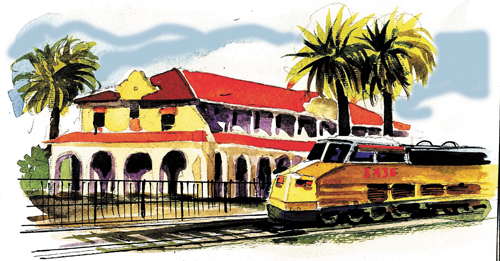Kelso Depot could see a return of passenger trains

Saved from the wrecking ball 25 years ago, the restored Kelso Depot now serves as a major information center in the sprawling Mojave National Preserve. Built in 1924, the Spanish Mission revival-styled depot served train passengers and railroad employees until it was closed by the Union Pacific in 1985. Citizen concern spurred an effort to salvage and restore the handsome depot, resulting in its eventual reopening in 2005. Existence assured, the depot’s future may include the return of passengers on special excursion trains.
Located less than 100 miles from Las Vegas by the shortest route, the Kelso Depot makes a splendid cool-season destination for a day trip or longer. To reach it, head south from Las Vegas on Interstate 15. Drive 51 miles to the Nipton-Searchlight highway exit a few miles past Primm. Head east toward the old town of Nipton, but turn off after four miles on the Ivanpah Road. After about four more miles, take the right hand fork onto the Morningstar Mine Road. Follow this road 18 miles to the remnants of Cima, a former railroad watering stop. Continue south from Cima 1 mile to Kelso, paralleling the railroad tracks.
The arrival of railroads in the desert changed the course of history in our area. When Sen. William A. Clark bought a small Los Angeles railway in 1900, he had bigger things in mind. His idea was to connect the interior Western states with the California coast with a railroad between Salt Lake City and Los Angeles. Soon, the Union Pacific Railroad became a partner in the enterprise. By 1905, constructed pushed tracks into the desert from each end.
Since locomotives powered by steam needed water to operate, the railroad planners located watering stops at intervals across the desert near available sources of water. Many desert communities began with the coming of the rails, such as Las Vegas with its abundant water and Station 16 near springs in nearby mountains, later renamed Kelso in a drawing of railroad workers’ names.
In 1905, a utilitarian depot at Kelso served the railroad’s needs. By the 1920s, the Union Pacific planned a series of depots meant to rival hospitality facilities built by competitors, such as the Santa Fe’s famous Harvey Houses. The Kelso Depot arose beside the tracks, an attractive and welcome sight.
Today’s visitors to Kelso Depot get a feel for what it was like nearly a century ago. Its wide verandas provide welcome shade. A lunch counter provides varied fare, coffee and beverages similar to offerings in the old days. Visitors can sit in the upstairs reading room in comfortable chairs such as those in the early downstairs waiting room, now occupied by a National Park Service Information desk. Former office space now houses exhibits on the Mojave Preserve, a theater for an introductory film and a well-stocked gift and book shop.
Visitors see where railroad business was handled in the restored ticket office, telegraph office and baggage room. Railroad personnel used small but comfortably appointed rooms upstairs, now furnished in period style. From the lobby, go downstairs to find an artists’ galley now featuring photos of the area’s tiny wildflowers. Clean, nicely restored restrooms are located nearby. Outside facilities include paved parking areas, picnic tables and restrooms.
Restoration continues in Kelso under National Park Service oversight. Salvaging a tiny one-room school opened in 1924 at the edge of town begins in 2011. The flat-roofed structure served generations of Kelso’s youth from the 1920s through the 1940s boom years when the nearby Vulcan Mine provided iron ore used in the building of wartime Liberty Ships. Kelso’s population then swelled to nearly 2,000 residents. Eventual closure of the mine and the switch from steam to diesel locomotives led to Kelso’s demise.
In October, a special trail starting in Los Angeles and picking up more passengers in Barstow made what supporters hope was an inaugural run to Kelso.
Passengers included officials, media and train buffs, pulled in vintage and Amtrak cars by a diesel locomotive on loan from Amtrak. They spent the day seeing desert, canyons, sand dunes and mountains from a different perspective. The "Kelso Flyer" was a big hit, underscoring possibilities for future excursions.
Margo Bartlett Pesek’s column appears on Sundays.












